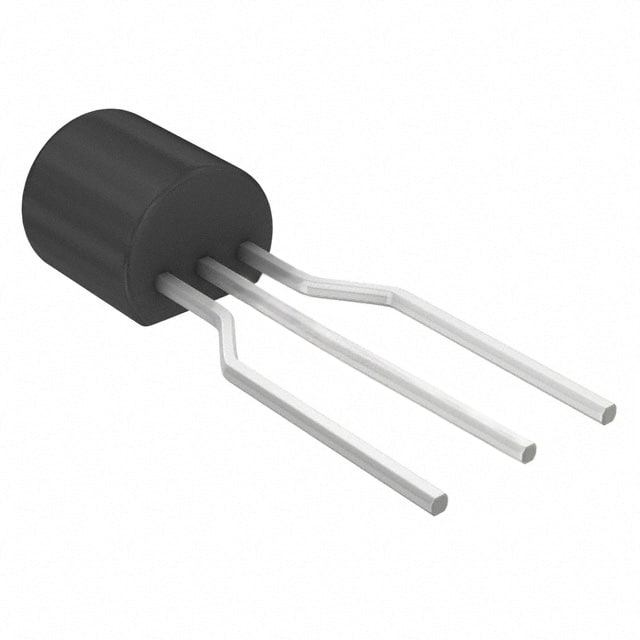Lihat spesifikasi untuk detail produk.

2N4402TFR
Product Overview
Category
The 2N4402TFR belongs to the category of bipolar junction transistors (BJTs).
Use
It is commonly used as a general-purpose PNP transistor in various electronic circuits.
Characteristics
- Low power dissipation
- High current gain
- Low noise
Package
The 2N4402TFR is typically available in a TO-92 package.
Essence
This transistor is essential for amplification and switching applications in electronic circuits.
Packaging/Quantity
It is usually packaged in reels or tubes, with quantities varying based on manufacturer specifications.
Specifications
- Collector-Emitter Voltage: 40V
- Collector-Base Voltage: 40V
- Emitter-Base Voltage: 6V
- Collector Current - Continuous: 600mA
- Power Dissipation: 625mW
- DC Current Gain (hFE): 100 to 300
- Transition Frequency: 250MHz
Detailed Pin Configuration
- Emitter (E)
- Base (B)
- Collector (C)
Functional Features
- High current gain
- Low saturation voltage
- Fast switching speed
Advantages
- Versatile usage in various electronic circuits
- Reliable performance
- Low noise characteristics
Disadvantages
- Limited power handling capability
- Sensitivity to temperature variations
Working Principles
The 2N4402TFR operates as a current-controlled switch or amplifier. When a small current flows into the base terminal, it controls a larger current flow between the collector and emitter terminals, allowing it to amplify or switch electronic signals.
Detailed Application Field Plans
- Audio Amplification: Used in audio amplifiers due to its low noise characteristics.
- Switching Circuits: Employed in various electronic switches and relay driver circuits.
- Signal Amplification: Utilized in signal amplification stages of electronic devices.
Detailed and Complete Alternative Models
- 2N4401: NPN complement of 2N4402TFR
- BC557: Similar PNP transistor with comparable characteristics
- MPSA92: Higher voltage and current rating PNP transistor
In conclusion, the 2N4402TFR is a versatile PNP transistor with applications in amplification and switching circuits. Its low power dissipation, high current gain, and low noise characteristics make it a popular choice in various electronic designs.
[Word Count: 324]
Sebutkan 10 pertanyaan dan jawaban umum terkait penerapan 2N4402TFR dalam solusi teknis
What is the 2N4402TFR transistor used for?
- The 2N4402TFR is a general-purpose PNP bipolar junction transistor commonly used in amplification and switching applications.
What are the key specifications of the 2N4402TFR transistor?
- The 2N4402TFR has a maximum collector current of 600mA, a maximum collector-emitter voltage of 40V, and a maximum power dissipation of 625mW.
How can I identify the pinout of the 2N4402TFR transistor?
- The pinout of the 2N4402TFR transistor is typically identified as the emitter (E), base (B), and collector (C) pins.
What are some common circuit configurations using the 2N4402TFR transistor?
- Common circuit configurations include common emitter amplifiers, switch circuits, and signal processing circuits.
What are the typical applications of the 2N4402TFR transistor?
- Typical applications include audio amplifiers, small signal amplification, and low-power switching circuits.
What are the recommended operating conditions for the 2N4402TFR transistor?
- The 2N4402TFR transistor is typically operated within a temperature range of -55°C to 150°C and with appropriate biasing and load conditions.
How do I calculate the biasing resistors for the 2N4402TFR transistor in an amplifier circuit?
- Biasing resistors can be calculated using the desired quiescent operating point and the transistor's base-emitter voltage drop.
Can the 2N4402TFR transistor be used in high-frequency applications?
- While the 2N4402TFR can be used in moderate frequency applications, it may not be suitable for very high-frequency designs due to its transition frequency characteristics.
What are the considerations for driving inductive loads with the 2N4402TFR transistor?
- When driving inductive loads, such as relays or motors, proper flyback diodes or other protection circuits should be used to prevent damage to the transistor.
Are there any common failure modes or reliability concerns with the 2N4402TFR transistor?
- Common failure modes include thermal runaway under excessive power dissipation and breakdown due to overvoltage conditions. Proper heat sinking and voltage regulation can mitigate these risks.

